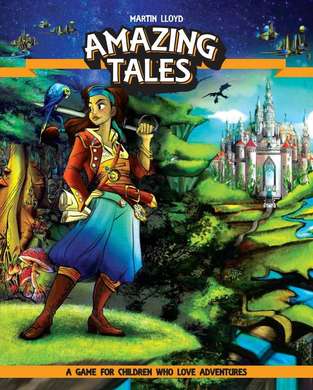 What can you do when you have no players waiting for you to blow their minds with a great story? Well, I looked to my kids one night after a bedtime story request. My trouble was that I find reading my kids bedtime stories to be more of a tedious chore, so I decided to stick to what I enjoy and pulled out a child-friendly RPG. Getting kids into roleplaying games can be tricky, the following are my choices of systems that I think are great roleplaying games to play with kids. 1) Tails Of Equestria Created by one of the writers of the My Little Pony TV show, this book contains the core rules and an adventure to get you started. All you need are character sheets, dice and some tokens to reward good roleplaying. The book takes you step by step through the very easy to read rules and character creation, with the addition of a starter adventure that would take two perhaps even three sessions. As it comes from an existing universe of characters and locations, there are lots of possibilities to grasp your young ones’ imagination, aided by a TV show that you can use as an inspiration source. 2) FATE Accelerated This version works better than Core FATE for kids, as the Approach system is far easier for younger kids to understand, compared to using a list of skills. Asking a child “what does your character do?” followed by “how does s/he do that?” then having them roll the dice and get excited about the result is very rewarding. There’s no setting too far for this generic system to work with: the sky, or underdark, or goblin mines, or starship… you get the point. My only advice is to get some ideas about a good point economy before just jumping in. 3) Amazing Tales Fairly new to the market, I picked this up as soon as I found out about it. It’s very simple and you can be running a game with your kids in around 10 minutes after opening the front cover. The character creation is fun and simple. You just need a name, picture, and things they are good at and your kid is ready to get adventuring. With only three parts to character creation kids should easily be able to concentrate long enough to get the job done, just fill out the super simple character sheet, of which there are a few designs (either text only or picture boxes to explain your skills), and you’re on your way. The rulebook comes with three child friendly settings for you to jump in feet first. 4) Lasers and Feelings This is a free, one page rule set that makes it simple to quickly roll up an entire game using only 3d6, although it is better with a few more dice. Within just a few steps and the provided tables you can roll up a character and the GM can quickly throw together a session. If you scout online you may even find homebrew variations including settings like Mouseguard. With only a single page of rules, Lasers Feeling is the simplest game to run: name your character, pick a number between two and five (inclusive), then roll up an adventure on the tables. Whatever game you choose from this list or elsewhere, make sure you keep in mind that children can have short attention spans which can lead to them not playing. This is fine, just call a break and come back another time. Including your child’s ideas into the game can prolong their enjoyment of it and focus, so be flexible and remember that if they enjoy playing now, you can run games for them and their friends creating the next generation of roleplayers. Let’s keep this great hobby alive! Ross Reid is a roleplay enthusiast who enjoys creating and running campaigns both as GM and player, he is currently in the middle of a one year CoC campaign with his original character still breathing, and has a preference toward the FATE games. He is currently working on a 24 hour roleplay marathon split over three days to raise money for a children's hospital in Edinburgh, Scotland. Picture Reference: https://www.drivethrurpg.com/product/222950/Amazing-Tales-complete-kids-RPG  There are plenty of fantastic systems available to gamers that come in a variety of complexities. While many of the “crunchier” games offer a lot to gamers, I personally find that rules-lite gaming offers just as much, but in a different way. These games often let myself and my players tell a good story without worrying too much about how far they can move in a turn or how many times they can cast a certain spell. An upside to rules-lite games is that they are easy for everyone at the table to grasp so you can jump right in. To sweeten the pot, many rules-lite games can be had for free. Below are five of my personal favorites. All of them are also “generic” meaning they can handle just about any genre you throw at them! 1) FATE Accelerated One of the most popular narrative systems available, FATE Core is derived from the FUDGE RPG and uses a nifty system of player defined abilities called aspects. FATE itself is rules medium, though it relies heavily on the imaginations of the players and Game Master. Evil Hat Productions then released a lighter version that was much easier to take on the go and accelerated gameplay. This version uses the aforementioned aspects and 6 approaches that define how your character will attempt to perform a task. Will they be forceful? Flashy? These kind of approaches determine the narrative direction for the action taken. The game itself is released under the Open Gaming License. 2) Mini Six This fantastic little gem was created using the Open D6 system, which originated as the Star Wars RPG by West End games. While Open D6 itself is available as a system reference document, I personally find Mini Six to be a better and more streamlined version of the game. The system itself uses a dice pool, allowing players to roll a number of d6’s equal to their stat+skill and add the results together. It’s a simple and straightforward game with several example settings and various optional rules included. 3) Risus This wonderfully goofy game has been around for 25 years and is still going strong. It is a whopping four pages long, with all the rules you’ll need to tell a great story. This game also relies on a dice pool mechanic where players roll a number of d6’s equal to their most relevant stat (referred to as cliches) and adds them together. The main pull of the game for many players are the cliches, which are player defined stats that can range from something like “Lady’s Man” to “Lovable Cyborg Bear.” Risus has a thriving community and is worth checking out if you like very simple and narrative games. 4) PDQ Prose Descriptive Qualities (PDQ) is another RPG that uses player defined stats (called Qualities) that range from Poor to Master level. Each level grants a penalty or bonus on a 2d6 roll. When a character fails at a task, they decrease the level of the the Quality rolled, which works well narratively to showcase how they are worn down by their failures. Several fantastic games have been made using this engine including the fantasy game Zorcerer of Zo and the superhero powerhouse, Truth & Justice. 5) Adventurers! This game boasts itself as an RPG in just two pages. While this is mostly true, it’s worth noting that the player’s guide and the Game Master’s guide are each two pages. The core mechanic is simple: roll 2d6+stat; a seven or higher is a success. The system offers skills that grant special abilities to make your character stand out more. While the game is rather small, it is most definitely complete and offers a variety of simple and compact rules to handle various scenarios. While the basic aesthetic is fantasy, the game can handle any genre. There are a plethora of mini settings for the system that can be had on the cheap as well. It is my firm belief that an amazing campaign can be had with nothing more than a few friends, dice, and some scrap paper. There isn’t really a need for stacks of books, miniatures, and an in-depth understanding of the game in question. So what are you waiting for? Go tell a story. Nathan Carmen is the founder and head writer of the Indie RPG company, Tricky Troll Games. Nathan loves building worlds and improving his craft when he’s not busy parenting. Reach Nathan at [email protected] or check out the TTG website at https://nathanccarmen.wixsite.com/trickytrollgames Picture Reference: https://www.evilhat.com/home/fate-core-kickstarter-highlights-3-fate-accelerated-edition/ 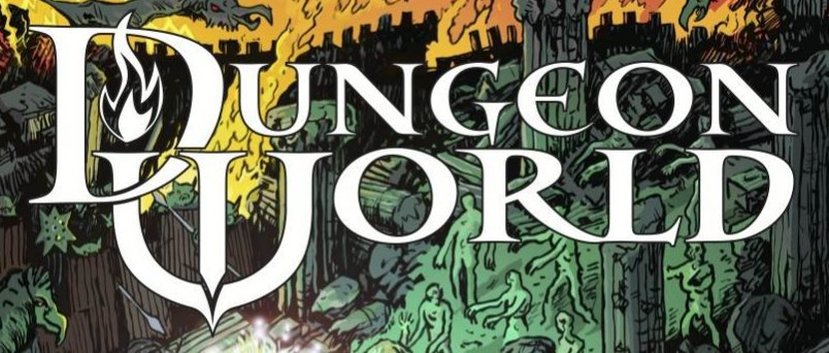 I have a new appreciation for games that are “Powered by the Apocalypse.” This badass moniker describes games are based on the rules used in D. Vincent Baker’s award winning Apocalypse World roleplaying game (now in its 2nd edition!). The first edition (published in 2010) became the framework for about a million spin-off games that recognized the genius of the system and applied it to different genres. Dungeon World by Sage LaTorra and Adam Koebel is one of these spin-offs, using the Apocalypse World rules to power a fantasy setting. This article is about some brilliant nuggets I found in the Dungeon World rules. I have never played Dungeon World, and although it’s hard to admit it, I haven’t played Apocalypse World either. I have a keen interest in apocalyptic-y themed fun and award-winning roleplaying games, but it wasn’t until someone posted about how the Dungeon World SRD helped them run a Fate Core game that I finally took time out of my schedule to investigate. It was worth every second. Here are a few mechanics that I borrowed from Dungeon World for use in a Fate-based game I ran recently. These mechanics have whet my appetite for more games Powered by the Apocalypse, as well as generally improving my gamemastering. I’m sure there are more gems to be found, but hopefully this is enough to get you interested in investigating Dungeon World and other Apocalypse games for yourself! 1) Agenda, Principles The first thing that drew me to investigate the game system was the simple gamemastering guidelines. A fellow Fate fanatic had posted that the Dungeon World Gamemastering section was great, and pointed out a few ways it was helpful to him. Dungeon World begins by laying out the gamemaster’s job in three bullet points: 1) portray a fantastic world, 2) fill the characters’ lives with adventure, and 3) play to find out what happens. Mic drop. Just kidding. They go on to hammer home exactly what is NOT the gamemaster’s job, including beating the players and testing their ability to solve problems. Especially hard to hear was that it is not my job to let the characters explore my finely-crafted setting. Once I choked that part down, though, I could see the wisdom. These three points are the reason that people play fantasy roleplaying games. Other agendas tend to just get in the way. There is then a list of Principles that the gamemaster should follow. I won’t list them here, though I will be drawing on a few of them in my other points. Suffice to say that LaTorra and Koebel simply take all the things that make a good gamemaster good and turn them into rules for the game. I took these to heart, and they changed my game for the better. Seriously, why didn’t anyone think of this before? 2) Focus On The Story Many games claim to be ‘story-based’ or ‘story-driven,’ and they all deliver to some extent. ‘Begin and end with the fiction’ is a gamemaster principle in Dungeon World, and the system backs the gamemaster up with the rules. What is unique about the Dungeon World rules is that they kick in only when something in the story triggers the rule. Conversely, the rules themselves generally feed back into the narrative, which mean that every interaction with the rules actually “begins and end with the fiction.” Rather than using rules to simulate the reality where a story occurs, Dungeon World ignores the simulation and instead uses rules to drive the story forward. This subtle shift in emphasis helped my players and I to focus on the fiction rather than the simulation, which ironically tended to make the game feel more real. We spent less time on using mechanics to explain situations and more time actually roleplaying. Win! We also avoided some of the sillier fantasy roleplaying conversations like “can I roll to persuade this character?” If you focus on the story, the answer is obvious: only if you make a convincing argument or have some leverage on them. So no. Or yes. Whatever makes sense in that situation! 3) Fronts Fronts helped me to plan the session and plant seeds for the future. One of LaTorra and Koebel’s gamemaster principles is to ‘draw maps and leave blanks.’ As anyone knows who has run a game, the best-laid plans rarely survive an encounter with the player characters. The answer? Plan less, but give your plans real teeth. Base your opposition on the player characters; what is important to them? Then advance the opposition step by step to the point that if the characters ignore it, the opposition will either suddenly or gradually destroy the things the characters love. That means that even if they spend a full session messing around in tavern in some backwater town, the plot will move forward and drag the players with it. Again, I’ve seen similar optional mechanics in other games (Aspect Events in Fate Core, for example), but LaTorra and Koeble roll it into the rules of the game, forcing you to have more fun. 4) Gamemaster Moves The heart of Dungeon World, and I assume all Apocalypse World derivatives, is the ‘Move.’ A Move is a rule that applies in a particular game-world context. For example, the “Discern Realities” Move happens when a character closely studies a person or a situation. Beginning with the fiction, the rule tells you what to do. Usually there’s a dice roll which defines what happens, and you explain the result in the fiction. To reiterate: the difference between this and other systems is subtle, but important. The context for making a Move is defined so that rules don’t have to be applied where they don’t belong. The best part, however, is the gamemaster’s Moves. They are a bit different. The gamemaster makes a Move in one of three situations: 1) when everyone looks to you to find out what happens, 2) when the players give you a golden opportunity, or 3) when someone fails a roll. At that point, the gamemaster chooses a Move that makes sense. There are only a dozen, but each one helps to create a compelling narrative. It means that whether a character succeeds or fails, something interesting is going to happen. This gem shines in that the story never deflates, even in the case of a failed action. It is always driven forward. 5) Reward The Desired Behaviour The final and most powerful mechanic is the Advancement mechanic. I had to tweak it quite a bit to make it work with Fate, but I could see the value in it, and the work paid off. Dungeon World awards experience points for advancement, much like Dungeons and Dragons, but the context is different. Instead of gaining experience by fighting monsters, you gain experience by failing a roll or by successfully achieving the goals of the game. What goals? Look back at the gamemaster’s agenda, and see if these question match up at all: 1) Did we learn something new and important about the world? 2) Did we overcome a notable monster or enemy? 3) Did we loot a memorable treasure? These three questions define the purpose of the game: to explore, kill monsters, and get treasure. The great thing is that the questions can change depending on the purpose of the game. Maybe you want a game that makes political power plays and rewards intrigue. Maybe you play a game where your characters protect the innocent from supernatural evils. Whatever the point is, it can be made into one of these questions. For the fairy-tale adventure game I ran recently, I used the following questions: 1) Did we learn something new and important about the world? 2) Did we overcome a memorable challenge? 3) Did we do good in the world? In addition to this, Dungeon World also awards experience points for portraying your character accurately. Players do this by, in character, resolving bonds and fulfilling their alignment. To convert this to Fate was super simple, because character aspects define characters in a similar way. Regardless, it was incredibly refreshing to see a roleplaying game that deliberately rewards players for playing their character! Apocalypse World changed roleplaying games by building rules around what actually happens at the game table. It can be adapted for any setting, if Dungeon World is any indication. The rules continually refer back to the fiction, keep the game moving forward, teach gamemasters and alike players to play well, and rewards them when they do. Are you going to try it out? Landrew is a full-time educator, part-time art enthusiast. He applies his background in literature and fine arts to his favourite hobby (roleplaying games) because the market for a background in the Fine Arts is very limited. He writes this blog on company time under a pseudonym. Long live the Corporation! Picture Reference: https://adventurerules.blog/2017/11/15/what-i-would-change-for-dungeon-world-second-edition/ 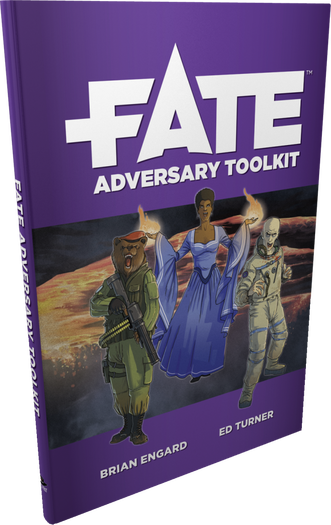 As a Fate enthusiast, I confess: when I heard that Evil Hat was going to publish a Fate Adversary Toolkit in August of this year, I was more than a little excited. It’s not often my five year old son asks me to stop bouncing off the walls. I got my hot little digital copy as soon as I could scrape together the $8 and beg Evil Hat to take my money. Now, though, it’s November; the honeymoon feeling has worn off, and I have to admit that I was disappointed about the purchase. I don’t regret it and I would buy it again in a heartbeat, as you’ll see toward the end of this article. Before you rush off to get your own copy though, here are some words and warnings for the wise spender of eight dollars. 1) Purchasing Problems Now, to be clear, these problems have already been remedied. For the eager gate-crashing purchaser, there was more than one obstacle to overcome, however. First of all, the site’s advertisements were not properly linked to the purchasing page, and there was no “add to cart” option available. That, and Evil Hat has discontinued its international shipping, which is annoying to those of us who do not live in the good old US of A. As a Canadian, I had the option to order from a store in Vancouver. I do not live in Vancouver. In fact, it is more than 1000 kilometers away. The good news? The store offers shipping! The bad news? At the time of release, the store did not have any copies available for purchase. I had checked into it again recently, and all of these complaints have been addressed. I am presently waiting/expecting to receive a hard copy for Christmas. At the time of the roll-out, however, the delay was insufferable because I wanted it right then!! 2) Short On Right-Sizing My greatest criticism of the book is that it fails to deliver on the implied promise of providing enemies that will appropriately challenge groups of different sizes and skill sets. The Fate Core rulebook has guidelines for creating opponents that will match or challenge the skills of individual characters and small groups, so that’s well and good. If you follow the core rules about creating advantages and sharing invocations, however, you can run into some fairly silly situations. I recently played with a group that faced off against a much more powerful foe and, by working together, the group took this big baddie out in one shot (+21 on the Fate ladder is an... “Unpossible”??). What should a GM do to create more challenging opponents for a large group of (four or more) players? How does a single character with a full complement of stunts match up with 20 mooks? Maybe I’ve been spoiled with Dungeons and Dragons challenge ratings, but even a couple of specific strategies to create a challenging encounter for larger groups would have been welcome. 3) NOT A Monster Manual The Adversary Toolkit features 10 nice little mini-adventures that span a wide range of genres, from Regency Romance to Post-Apocalyptic mutants. Each mini-adventure has opponents and sample NPCs embedded within. What it does not have is a list of stats for various monsters, neither mooks nor main NPCs. If that’s what you want, you’re better off looking for fan-made resources, like the Fate Fantasy Creatures site by Inkwell Ideas. This is the second implied promise broken. Granted, given the range of possible genres in Fate, it is impossible to make a comprehensive list of creatures and characters for every genre. It would have been nice, though, to have a list of opponents that goes beyond singular adventures, something for the GM to grab when he’s short on planning time. The one mitigating factor of this problem is that the opponents provided in the mini-adventures could be re-skinned for use in other genres if needed. There are even suggestions for re-skinning included. Nevertheless, that requires more hunting and editing than I was hoping for. 4) Threats & Hitters Now, without unsaying the above criticisms, the book is not a total loss. Hidden in the disappointment, there are a few bright lights. The book suggests the Threat and Hitter character designs, for example. When grouped together or tied to a Main NPC, these supporting characters can flesh out a combat that otherwise might become straightforward or routine. Threats are supporting characters that are meant to be big and scary; they get in the characters’ faces and soak up a lot of damage, while dealing just enough that they can’t be ignored. Think of the big bruiser henchman in a Bond flick: Jaws shows up and gives the main villain just enough time to escape. Hitters are less scary, but more dangerous: a sniper that’s far away, or a ninja master that’s hard to hit but can take players down one at a time. Hitters represent threats to the group that must be dealt with quickly once they’re discovered. Both of these character types add depth and flavour to a combat scene. Perhaps they can be used to challenge a group that has mastered the classic Fate collaborative takedown. 5) Obstacles, Constraints & Environments Obstacles, constraints, and environments are ways to use the Fate Fractal creatively in order to make memorable sessions and scenes. From a mechanical perspective, these three "adversaries” are not easily distinguishable from each other. They are more like variations on a common theme, non-character things designed to get in the way of, and/or do harm to, the PCs. They are details with teeth. Again, by using these guidelines, it might be possible for a GM to split a group’s resources enough so as to create challenging combat scenes that can resist the “dog pile” effect of combining free invocations. The Fate Adversary Toolkit adds another layer to the complexity of Fate Core, which is both a strength and a weakness. Fate’s strength is that the rules remain flexible but robust enough to improvise nearly any situation. Fate Core rides the edge of this balancing act. The rules are simple enough to allow for flexible gameplay, but this works best if a substantial amount of background preparation has already been done. The gamemaster needs to have prepared at least some NPCs and possible scenes in advance for the game to go smoothly. The Adversary Toolkit adds things you can do during background preparation. What it does NOT do is make the preparation work any easier. Landrew is a full-time educator, part-time art enthusiast. He applies his background in literature and fine arts to his favourite hobby (role-playing games) because the market for a background in the Fine Arts is very limited. He writes this blog on company time under a pseudonym. Long live the Corporation! Image Source: Evil Hat Games 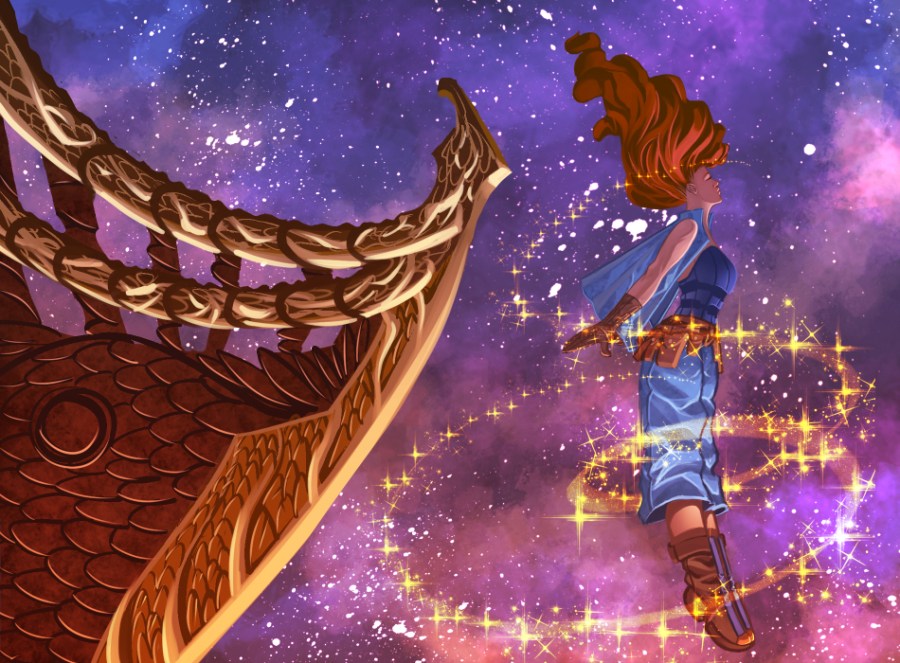 This is the final entry for a series of articles where I share some of the detailed characters, places, and things created during a recent campaign. The campaign used Evil Hat’s Fate system, and took place in Edward Turner’s “The Aether Sea” world. We decided as a group to use Fate Core rather than Fate Accelerated Edition, so the things presented here will work better with Fate Core. For easy playing, “The Aether Sea” has an adventure included, complete with detailed characters and backstory. Following that, it sketches out some possible adventures, but it really only gives you the bones; it’s up to the group to make the suggestions into full adventures. Here is the ‘meat’ that our group put on the bones suggested by Ed Turner. The game items presented here were spun out of an adventure prompt at the end of the Aether Sea book, which I will quote later. First, I’ll describe the setting of the adventure, then give a description of how the prompt might play out. The descriptions and characters are our group’s take on the adventures suggested in the book. That being said, Fate lends itself very easily to creating your own characters and details. Take what I write here and play them as full-on adventures, or simply take some inspiration from them and build your own adventures from the suggestions! In this article, I’ll continue adding some detail to the “Julian’s Bluff” adventure that I began sharing in my previous article. 1) The Rebel Forces The rebels are classic freedom fighters, with a twist. There are two powerful families on Julian’s Bluff: the Graves, and the Millers. The Millers are more powerful, but corrupt. In order to defeat the Hegemony, though, the two families had to join forces. In a canny power move, the Miller family managed to put one of their own in charge of the rebel army. General Sigmund Miller One of the big baddies. Lieutenant Precious Graves is a good-natured thorn in his side in place because of political pressures, but the General can talk circles around him. The General reprimands a disobedient soldier while Graves is around, then welcomes & reassigns him when Graves leaves. High Concept: Cruel Commander of Rebel Forces Trouble: Sociopath Aspects: Only the strong are fit to rule I know what I'm doing Undying devotion to my planet +7 Fight, +6 Resources, Notice, +5 Provoke, Physique, Rapport +4 Will, Shoot, Deceive Contacts 4 Physical Stress, 4 Mental Stress, Consequence slots as normal Stunts: Tactician: +2 to create advantages using Fight when directing loyal soldiers I know people: Use Notice in place of Empathy to determine if someone is lying Henchmen: can call on 2 additional Good NPCs once per scene. Lieutenant Precious Graves Lieutenant Graves came from the next county over as a military specialist in a gesture of friendly alliance. He is in command of much of General Miller's forces in the field. Has been referring bad soldiers to Miller; Miller reassigns them to a corps loyal to himself. High Concept: Athlete-Turned-Soldier Trouble: Easy Mark Aspects: Can't wait to be with Annabel again Serendipity Competitive Athlete +5 Athletics, +4 Shoot +3 Fight, +2 Rapport, +1 Physique 3 Physical Stress, 2 Mental Stress, 1 Mild and 1 Moderate Consequence Slot Stunts: Honest Abe: Use Rapport to inflict mental stress on people trying to harm him. 2) Julian’s Keep: The Royal Hegemony Presence The rebels outnumber the Hegemony five to one, but the Hegemony presence has better weapons. Nevertheless, the Hegemony has been pushed back to just one area, protected by a fortification known as Julian’s Keep. The rebels currently have Julian’s keep under siege. The Hegemony has long since stopped funding this war, however. The only thing keeping them there is General Tanner and his genuine concern for the population of Julian’s Bluff. General Arcturus Tanner Tanner is intended as an main opponent to the player characters, but should definitely be a sympathetic villain. He refuses to leave because he knows that General Miller will seize control and the population will suffer. High Concept: Beloved leader of Hegemony forces Trouble: Fighting in the Alamo Aspects: Death before dishonour Sigmund Miller must be stopped! Rich sense of tradition +7 Rapport, +6 Fight, Notice, +5 Resources, Physique, Lore +4 Will, Shoot, Deceive, Contacts 4 Physical Stress, 4 Mental Stress, Consequence slots as normal Stunts: Honest Abe: Use Rapport to inflict mental stress on people trying to harm him in social situations. Rally the Troops: +2 to create advantages using Rapport when directing loyal soldiers Loyal Troops: can call on 2 additional Good NPCs once per scene. Lieutenant Harvest Lieutenant Harvest is the department head of the Royal Alchemical Society on Julian’s Bluff, whom, if you remember, the player characters were meant to deliver their cargo to in the first place. These materials are used to power and maintain the Titan Spiritual Anthroform, a weapon vital to the war effort at this juncture. High Concept: Science! Trouble: Squirrel! Aspects: Former Reporter Dogged Co-Workers tolerate my genius +5 Investigate, +4 Lore, +3 Shoot, +2 Crafts, +1 Will 2 Physical Stress, 3 Mental Stress, Consequence slots as normal Stunt: Socratic Method: Use Investigate to create advantages in social situations by asking persistent questions. 3) The Hope’s End Standard Per chevron advanced azure and argent, a cinquefoils vert in middle base… If the characters agree to steal the Hope’s End Standard, here are the stats for it. Stealing the standard will require meeting a series of at least two Challenges that follow a progression of Easy (-2 to character’s stat), Challenging (+0 to character’s stat), and Difficult (+2 to character’s stat). To fence the Standard to anyone except General Miller without consequence (aside from losing the hostage) is a Superb (+5) Challenge. Here are the overcome difficulties that characters may face to learn more about the Standard using Lore, Investigate, or Contacts. Be prepared to make stuff up, or have the characters invent what they know: Fair (+2) The name rings bell, and the characters have heard a rumor Good (+3) The characters can identify the Standard, and have heard a rumor Great (+4) The characters can identify the Standard and know one fact Fantastic (+6) Comprehensive history High Concept: Ancient Enchanted Standard Trouble: No loyalty Extras: Boon: Bestows the aspect Protected by the Hope’s End Standard on any one thing with a high concept that is carrying it. This could be a character, group, vehicle, building, sector, etc. Only one thing may have the aspect at a time, but it can be invoked by anyone that can be considered under the protection of that one thing (e.g. anyone in the vehicle, building, sector, etc.) Lucky: The standard has its own refresh of three fate points that may be used to invoke aspects as if the standard were a character. These may be used to invoke Protected by the Hope’s End Standard. Refresh: 3 (Cost: 2 Refresh. A character must give up 2 points of refresh in order to gain this extra. Refresh given up in this way may be regained by giving the Standard away) 4) Titan Spiritual Anthroform I love steampunk. The Titan is a giant mech made of brass and rivets, powered by the spirits of the damned. It’s on loan from our friends at the Annular Necrocracy. If the characters agree to investigate the rumor about a new weapon, this is what they’re looking for. Getting information about the Titan will require meeting a series of at least two Challenges that follow a progression of Easy (-2 to character’s stat), Challenging (+0 to character’s stat), and Difficult (+2 to character’s stat). To steal it would be next to impossible (see the aspects below). If your characters are looking for a fight, look no further. Small Ship Scale (+2 to Physique, Fight, Athletics, and Provoke) High Concept: Used Combat Mech Trouble: Where’d you go?/That damn blind spot Aspects: Necromancers only Fully customizable & customized +4 Physique, +3 Fight, Athletics +2 Crafts, Notice, Shoot, +1 Will, Deceive, Provoke 4 Physcial Stress, 3 Mental Stress, 1 additional mild consequence slot Stunts: Big Metal Body: Use physique to defend against physical attacks. Flame Thrower: Fire Good (+3) fireballs at a target in the same zone. Eject! Eject! Once per scene, the pilot may eject to safety and the Anthroform will collapse, triggering a Good (+3) attack on everyone in the zone as it falls to the ground and flails about. 5) Henchmen These supporting characters can show up wherever you need them for a big fight. They might be a motley crew of mercenaries belonging to the Hegemony, or they may have defected to the rebels. Put them with whichever General you want when you need your characters to face some serious opposition. There is no backstory for them, except what is suggested by their aspects, so feel free to invent your own! Brace (Dwarf; group leader) High Concept: The group’s loud voice Trouble: I want the boss’ job... Aspects: Pride goeth before all I’ve seen that before… Profitability over honesty +4 Fight, +3 Rapport, +2 Notice, +1 Athletics Rally the Troops: +2 to create advantages using Rapport when directing loyal soldiers You Mad, Bro? Use Rapport in place of Provoke to cause mental stress. Swashbuckler: +2 to create advantages using Athletics Freeze (Elf) High Concept: Registered SCU Evocation Expert Trouble: Brace makes me unsure of myself Aspects: Dogged dreamer Solution oriented Cold (Empathy with Frost) +4 Magic, +3 Athletics, +2 Fight, +1 Notice Stunts: Focuses on Frost in Evocation: Use Magic to cast Frost-related effects to attack, defend, overcome, and create advantages. Dabbles in Evocation: Given enough time, can use Magic to create effects using fire, earth, water, lightning, etc. Cast-Fighter: Once per scene, gain +2 when using Fight for the first time. Surprise! Michael (Troll) High Concept: Enforcer Trouble: These people move too fast. Aspects: Eureka! Honesty over profitability Methodical +4 Physique, +3 Empathy, +2 Athletics, +1 Fight Stunts: Shrug it off: Use Physique to oppose Fight. Wise ways: +2 to create advantages using empathy Tough as nails: Once per scene, reduce the severity of a physical consequence. Vuzz Fletcher (Goblin) High Concept: An actual fletcher. Trouble: I ain’t no royal. Aspects: Something’s not right… A name within the field Just do the job +4 Shoot, +3 Fight, +2 Notice, +1 Athletics Stunts: Coward: +2 to Athletics when avoiding harm. Robin Hood: Create a lasting aspect instead of a boost on success with style using Shoot Robin Hood 2: Use shoot to overcome obstacles where it usually wouldn’t apply (subject to gamemaster approval). Hope all this was useful, not just tl;dr. That was Julian’s Bluff; I hope that you can have fun with it, too. If you decide to make use of these resources, please leave a comment to let me know how it goes! Landrew is a full-time educator, part-time art enthusiast. He applies his background in literature and fine arts to his favourite hobby (role-playing games) because the market for a background in the Fine Arts is very limited. He writes this blog on company time under a pseudonym. Long live the Corporation! Image courtesy of drawshield.net |
All blog materials created and developed by the staff here at High Level Games Archives
April 2023
Categories
All
|
Proudly powered by Weebly
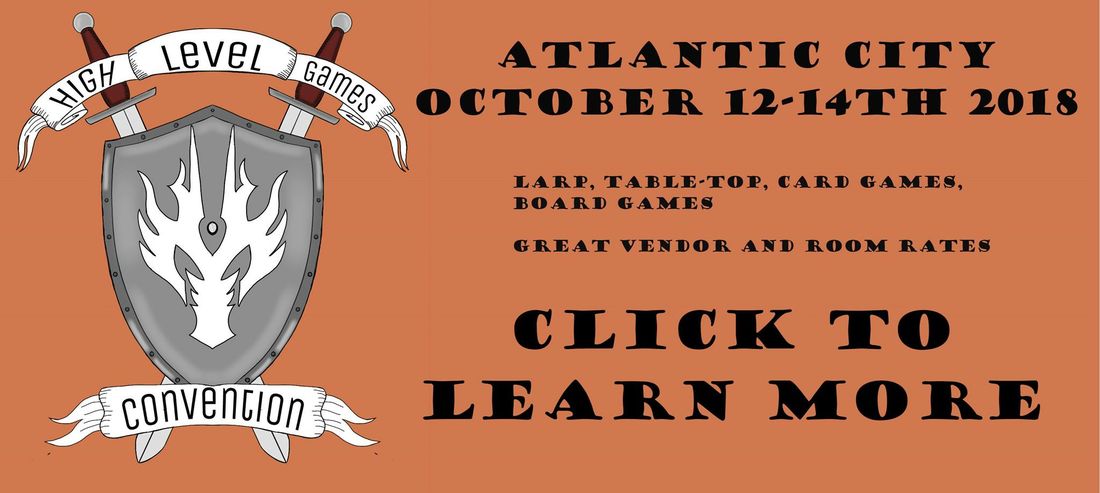
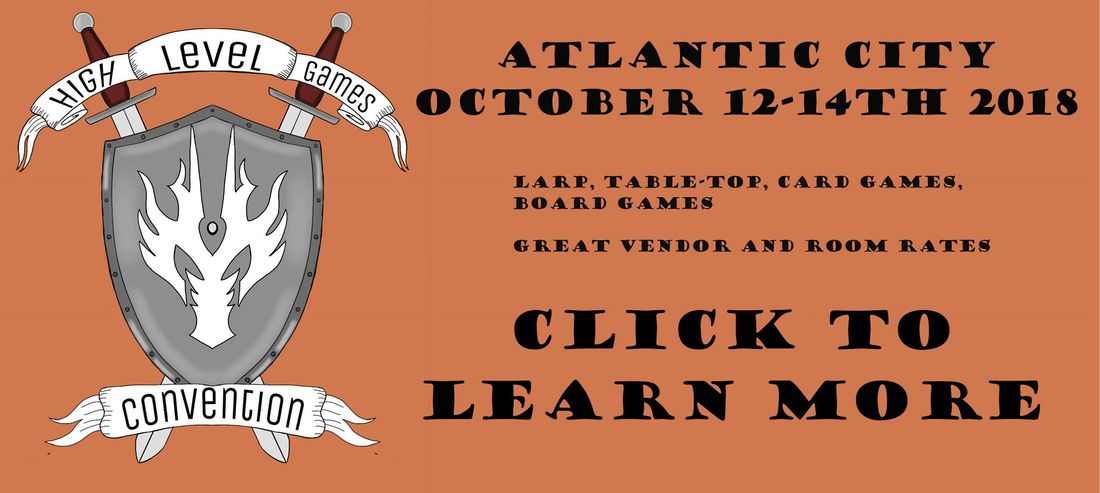

 RSS Feed
RSS Feed